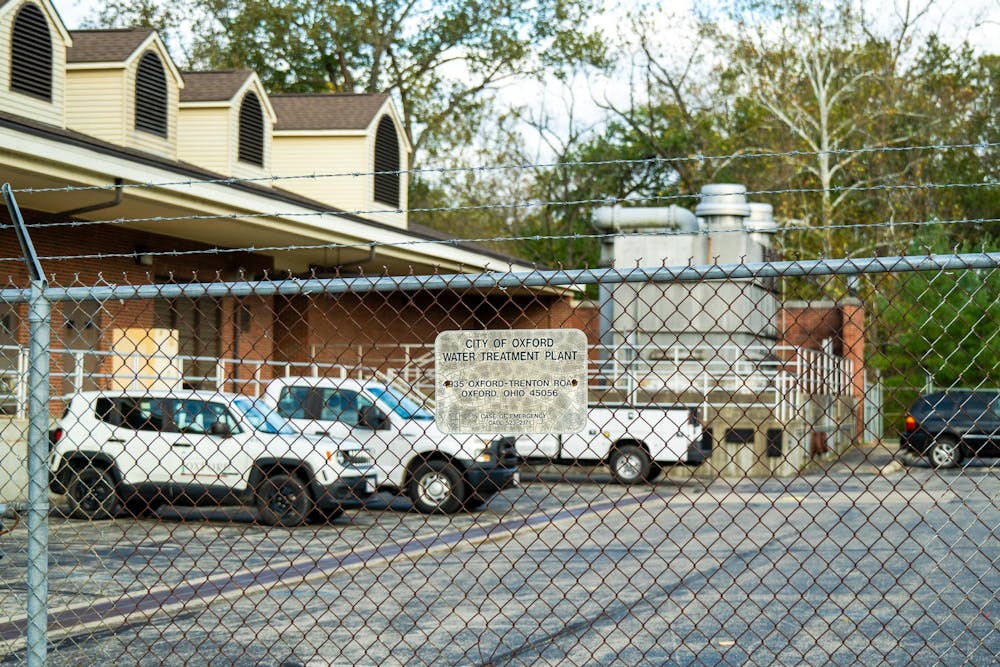Avery Caldwell, a junior primary and special education major, lives in a six-person house near Elm Street. Following their arrival into off-campus housing, Avery and her roommates noticed something unusual about their water.
Caldwell said her hair felt waxy and straw-like, along with a general feeling of not being clean after showering. She bought resources such as shower head and drinking water filters for her home as a result.
“Showering is a lot more difficult because of the [shower head] filter,” Caldwell said, “and the water pressure isn’t as strong.”
While the problem isn’t exactly fixed by these filters, Caldwell said she could tell a difference. Her discomfort was not caused by the cleanliness of Oxford’s water, but by its hardness.
According to Oxford’s Drinking Water Consumption Confidence Report for 2024, Oxford’s Water Treatment Plant pumped nearly 841 million gallons of water from wells located near the Great Miami Buried Valley Aquifer (GMBVA). The GMBVA holds around 1.5 trillion gallons of water and is a federally designated, sole-source aquifer.
Oxford’s naturally hard domestic water supply is produced from the GMBVA. This source of water passes through deposits of limestone, containing high concentrations of calcium and magnesium. These minerals are responsible for hair breakage, dry skin, mineral buildup and reduced appliance efficiency.
This doesn’t mean Oxford’s water is substandard; it’s simply hard water. This is certified by the work of Oxford’s Water Treatment Plant.
The City of Oxford’s Water Treatment and Distribution Division serves over 22,500 customers, providing water to Miami University as well as Oxford homes and businesses..
Todd Kehr, Oxford’s Water Treatment Manager, describes a typical work day as performing daily water sample tests, which include documenting water pumped the day before and keeping a general overview and maintenance of the plant.
“We test chlorine and fluoride on a daily basis,” Kehr said. “There are other chemicals required by the [Environmental Protection Agency] that we test for on a quarterly basis.”
Faculty of the treatment plant ensure the safety and quality of Oxford’s drinking water through the use of rapid sand filters and a water booster station located near Contreras Road. These systems help remove possible contaminants from the supply and maintain adequate water pressure for drinking and distributing Oxford’s water.
While the quality of domestic water is clean and safe, the hardness of Oxford’s water still causes some concern from students. Kehr said the city has begun early engineering of a water softener system to help ease these concerns.
Enjoy what you're reading?
Signup for our newsletter
“It’s in the very early stages,” Kehr said, “but it is a project that the city is working on and looking forward to getting started.”
This water softener would remove more hard minerals like calcium and magnesium from the water used by residents. Benefits of removal include better protection from mineral buildup, reducing maintenance costs and increasing the efficiency of water heaters, boilers and other equipment. Water softeners also improve cleaning as soaps and detergents are more soluble in soft water than hard water.
Until the water softener is put in place, Oxford residents can use some simple techniques to combat hard water, such as making homemade cleaning solutions and buying utility modifications.
The addition of baking soda or vinegar to washing machines can help prevent damage to clothes by breaking down hard water minerals; however, caution should be taken for this method, as some clothing materials don’t react well to baking soda or vinegar.
The use of citrus when cleaning can help dissolve hard water minerals through natural acidity. This means residents can create their own natural cleaning solution by mixing water with a squeeze of lemon juice. The most common ways to combat Oxford’s hard water include installing a shower head and water filters, like Caldwell and her roommates did.
Kehr emphasized the importance of keeping clean and high quality water for Oxford residents.
“I’ll just reiterate the amount of effort and pride that the operators put into maintaining this plan,” Kehr said, “to ensure that the distribution department keeps up on the testing and systems.”
The City of Oxford looks forward to this new addition, as do many students and staff at Miami.




